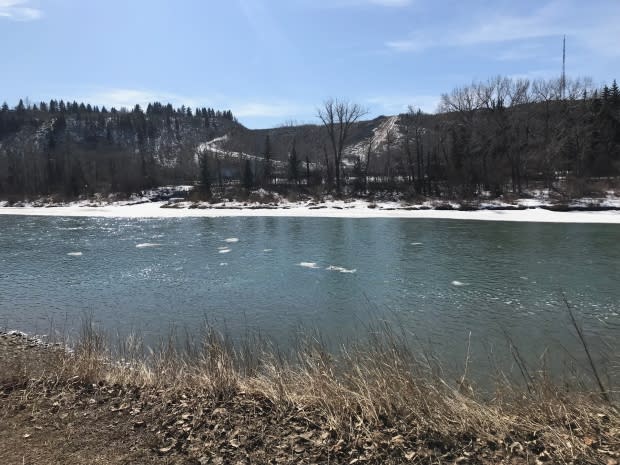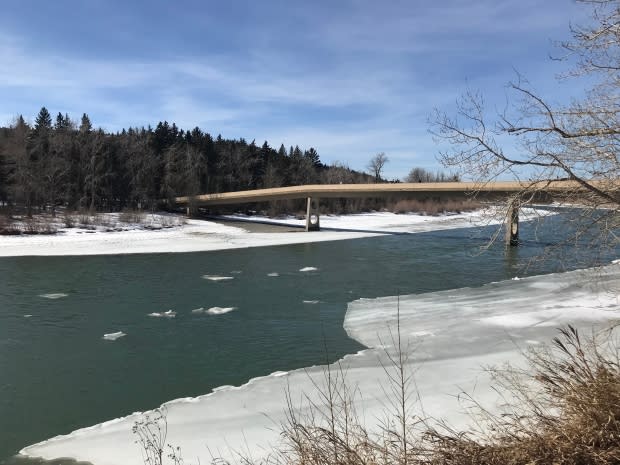As Calgarians eye melting rivers, experts say there are no big signs of flood
It's become a natural part of spring in Calgary.
As the temperature soars and the snow melts, many Calgarians will to cast their eyes to the Bow and Elbow rivers — watching for any sign of rising water levels.
The 2013 floods left many people with a feeling of unease at this time of year.
"When we're downtown, and I look at the Bow, I always think, 'OK, could this happen again,'" said Calgarian Jad Sabalbal, who was living downtown when the 2013 floods hit and had to get out in a hurry.
Melting ice chunks flow down the Bow River as he walks along the pathway with his wife and 10-month-old twins.
"When I look at the water levels, even now they look pretty high, to be honest. So certainly I do look at the Bow River differently since 2013," he said.
Flood predictions underway
Sabalbal isn't the only one watching.
A city river engineering team is monitoring the snowpack, melt rate and water levels all around Calgary.
"Right now, there isn't a significant concern for overall river flooding," said Frank Frigo, leader of watershed analysis with the city.
According to Frigo, even though it's warm in low-lying areas, it's not yet warm enough at higher elevations to melt the mountain snowpack.

Another key factor in flood prediction is weather. The team monitors patterns such El Nino and the ocean current temperature, which drive precipitation levels here.
"So we're watching for major low pressure systems that are developing out in the Pacific, understanding their trajectory and understanding which ones may be able to bring additional moisture — either in the form of rain or snow — to our catchments, the Elbow and the Bow basin, as well as Nose Creek, Pine Creek and Fish Creek," said Frigo.
Calgary's flood season typically runs from mid-May to mid-July because that's when the region tends to get the most rain.
"This early in the season … it would be unlikely [to get] the moisture volumes that can create large scale river flooding to actually occur," said Frigo.
"So we generally haven't seen that in the record and it's something we continue to monitor."

But, according to Frigo, there are signs that at least one of those timelines may be starting to change.
"Both last year and the previous year, we saw an earlier than average snowmelt runoff, so we're continuing to watch that. That's one of the signals of a changing climate," he said.
If there's an upside to the earlier melt, according Frigo, it's that the rapid snowmelt and heavy rains don't necessarily come at the same time — splitting up two conditions that when combined can lead to flooding.

Experts watch U.S floods
Other flooding experts have their eyes on the skies right now, too.
John Pomeroy, a University of Saskatchewan hydrologist who runs a research lab in Canmore, says there is more snow on the ground than usual in the prairie regions of southern Alberta
"It was a February without chinooks. So the snow eater didn't come and remove the snowpacks over southern Alberta, so they're still in place to melt. That's a bit abnormal for us. So we'll see higher runoff in some areas because of that," he said.
With the ground still frozen in many places underneath that lingering snowpack, a heavy rain could be cause for concern, according to Pomeroy.
That's what happened south of the border, where unprecedented flooding in several midwestern states is being blamed for at least three deaths.
"They had the same conditions. But with the warming that we have right now, they also had heavy rains. And that pushed them into all-time record flooding in the prairie part of Nebraska, and the peak flows ever recorded on the Missouri River."
But Pomeroy says he doesn't see any heavy rain in southern Alberta's short- or long-term forecasts.
"The large scale events, such as we had in Calgary in 2013, there's no indication of anything like that at this point. But lots can change.... We're not out of the woods until July."

